If you are new here, don’t forget to check our Discord Channel. it’s free for everyone!
If you are looking for more UW Control control, click here.
Introduction
For the longest time, I used to play control decks almost exclusively. It was the thing in Magic that brought me most joy, which I think is the most important factor for the vast majority of players, especially those who aren’t earning their livelihood via Magic. It’s also a fairly limiting trait for those who are trying to win more at the game, which prompted me to abandon this devotion to my beloved archetype a few years back. Make no mistake – I still have a lot of bias in terms of deck selection, I just let myself more loose so now I will play whatever the best blue deck is instead of limiting myself to those which can’t reasonably close out the game. However, when presented with two identically strong blue decks, I still will choose the more reactive one fairly often – I just learned to recognize when those decks aren’t good enough to pick up, which in turn allowed me to get better at identifying what makes control work in Modern and when’s the right time to pick up your Supreme Verdicts and Solitudes. I hope this article will be a decent enough insight into my deckbuilding process, what constitutes a good control deck and when it’s best to turn your eyes in a different direction.
The List
Since I hope that this article will be at least somewhat evergreen, my current list isn’t terribly important, but it still has some value context-wise, so here it is:
You can find a downloadable version here.
Restraint
I’ve decided that the best way to present this article is to come up with a list of major characteristics I’m looking for while building my deck and go over them one by one. The first one on the docket is restraint, which I divide into two main parts: restraint when it comes to value and colours.
Restraint in terms of value
Let’s start with restraint in terms of cards. It’s very common for attrition decks of any category to end up in this possibly unending arms race against other similar strategies, which, while admittedly helps in the head-to-head matchup to some extent, hurts your winrate overall more than it helps it. In a format as wide as Modern, where you will often encounter opponents that either will try to under you and kill you while you still have resources left, go over the top with a combo finish or just won’t care about the attrition game in some other way (eg. Burn), I think it’s important to find the right balance between generating value so you can take over the game reliably, being efficient enough to keep up with faster decks and having a plan to tackle opponents who are trying to go over the top of you.
The first part is easy for most deckbuilders, as people often overcorrect in this aspect: find a plan to get ahead once you stabilise. It used to be powerful planeswalkers like Jace or Teferi, and now the best thing out there for the job is The One Ring. You can argue that Up The Beanstalk belongs in the same group, and while it’s definitely at least partially true, I have a lot of gripes with the card, first of which ties quite neatly into my second point – staying efficient. Yes, Beans will let you play more pitch spells and get your cards back after you evoke Solitudes and such, but if you don’t have Beans in play early, your deck will struggle. That’s why many players correctly identified that more Beans is better, and included cards like Shardless Agent or even other inferior cascade cards in their decks to have better access to their engine. That’s all well and good, but if you’re facing decks that can punish you for effectively cycling or casting oversized Elvish Visionaries on turn two or three, you can be in a lot of trouble. I can easily imagine Beans snowballing better than The One Ring, but the latter grants you the crucial layer of protection and basically will always net you the first three cards to help you make up for taking a turn off to cast it. All in all, I think that The One Ring is a better card advantage Engine than Up The Beanstalk, but Beans are still at least decent. What’s actually offending in my opinion is playing both of those – you just don’t need this density of card advantage, and neither Beans nor Ring pitches to your free interaction, which make your already somewhat clunky Beans deck even clunkier. My advice is to pick a line and stick to it, and I think that The One Ring is the better one unless you expect your Solitudes and Furies to be amazing in every single round you play.
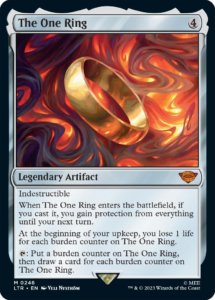
This leaves us with the last attribute I listed at the beginning of this section, and it’s having a plan to tackle those decks that given time will overpower basically any amount of value generated on the other side of the table. If you still want to play Beans over the Ring, I can’t recommend Commandeer enough for this particular role – it should cover most of your problems in this department, and when paired with Force of Negation, it grants you a decent density of free permission which will allow you to tap out with relative impunity. More generally though, the best way to ensure this is to have a coherent plan against those decks, which usually means having a combo finish in your control deck. I’m gonna cover it in the later section of this article in more detail, but this is a first of many remarks that will hint about combo control being my preferred way of building those decks.
Restraint in terms of colours
The other area in which in my opinion people tend to be too frivolous is picking which colours to run in their deck. Back in the day, the Modern card pool was both smaller and lower in power level, so you often needed to branch into tertiary colour to ensure your control deck had the right tools for the job. These days there are so many insanely strong cards in the format that it’s no longer the case. Even if you’re staying in two colours, there are so many things you won’t be able to fit in your deck that used to be absolute staples of formats even past Modern. Hell, if you look at the list I posted at the start of this article, you’ll notice that my maindeck has only three four-ofs. Three! There’s simply not enough room to fit everything while staying at sixty cards, even without adding a whole other colour. Imagine how many excellent cards you’d have to cut in order to fit those very best red, green or black cards you’d like to splash – I don’t think that the power level jump would be that high, and the price you have to pay for doing so has never been steeper. When you add an extra colour into your deck, you have to stretch your manabase tremendously, even with a bevy of fetchlands to help you out. It’s kinda baffling to me how people will tinker with their spells, agonising whether it’s worth to go up to 69 cards or if staying at a nice cool 67 is better to eke out an extra percentage point or so, while they completely omit all that equity they’re losing due to their shaky manabases. The thing about your lands is that you will use them in every game, no matter what matchup you’re facing, so it’s of the utmost importance to guarantee having a quality manabase that will suit your needs. The most important parameters I’m looking for are in order: number of coloured sources, life loss that your manabase inflicts upon you, vulnerability to nonbasic land hate, taplands and utility lands.
Let’s start with the biggest one – how many coloured sources you need to consistently cast your spells. This is an enormously large topic that I could go on about for pages and pages, but luckily for both you and me, Frank Karsten has been crushing it for years at this point, releasing new instalments of his excellent series “How many sources do you need to consistently cast your spells?” every now and then. You can find the newest rendition I was able to dig up here. Go ahead and read it now if you haven’t already. If you did, go and read it again – it’s worth it. I’ve spent dozens of hours looking at those tables, internalising them and applying what I learned to my decks. Do so yourself, and you’ll start winning more games of Magic.
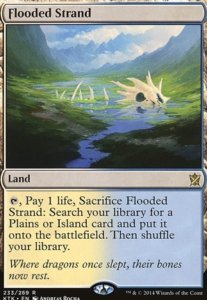
The rest of those manabase attributes I mentioned are, while still important, visibly less significant than the first one, so I decided to bundle them in this one paragraph. As far as the life loss goes, this is probably the place in which more than two colours will hurt you the most. Having that seemingly low cost splash of Up The Beanstalk in your UW deck, even if the math on coloured sources works out, will cost you a bunch of life every game since you need to fetch an untapped Breeding Pool so much more often than you’d like. But even in two colours, there is still a non-trivial amount of life loss present. The biggest offenders here are obviously fetchlands and shocklands. I would usually consult with Karsten’s table how many sources I need for my spells, and then cut any superfluous sources of self-inflicted damage until I get to those desired values. Usually I like to limit my shocklands first, as fetchlands have a long and storied history of being the best nonbasics in the game for a reason, many of them still true today. One of those countless advantages is helping playing around nonbasic hate, such as Blood Moon, in tandem with basics obviously. I usually like having enough basics in my deck to satisfy every colour requirement in my deck off of them, a handy habit I picked up from Legacy players and their everlasting fear of Wasteland. Admittedly, you don’t have to face the same menace in Modern, but with Scam being by far the most popular deck in the format and sporting some copies of Blood Moon, it’s nice to have plenty of basics and ways to find them so you don’t have to worry about a random hate card topdecked on turn ten locking you out of the game. Usually, if I have all five land types for my Binding, I will try to fetch basics exclusively if I’m facing a possible Blood Moon. Obviously, you can’t do that every game, and fairly often you will have to grab a Hallowed Fountain to tie the room together, but think twice before fetching a tapped dual over a basic as your fifth or so land, even if it’s seemingly “free”. Taplands kinda ties to this as well, seeing as basically all you’ll play these days can be fetched. If you have Binding in your deck, you need to have two Triomes that will complete Domain for you, but any further copies are excessive in my opinion, as far as shocklands go, I’d love to play only one Hallowed Fountain, but I don’t think it’s feasible with turn one white plays and double blue requirements on turns two and three. Breeding Pool enables Ending for four with just Raugrin Triome on the table and has a nice upside of being able to cast Kaheera, but in general, this is the part of the manabase I’m least sure about and I can definitely see a world in which I end up cutting it. That leaves us with utility lands. Back in the day, you could’ve run much more of those between manlands, Field of Ruin and such, but now, with Triomes and Binding monopolising manabases and significantly heightening the cost of every lands without a basic land type, you can’t really find the room for more than a couple copies. I would usually prioritise those who tie into your strategy the best – for this deck it’s Geier Reach Sanitarium and Minamo. Hall of Storm Giants is a good candidate as well, but there’s not enough room for it in my current manabase, and it’s markedly less needed than the first two.
The last beneficial part of staying in two colours is the number of cards you can pitch to your free spells. It’s an often overlooked aspect that seems quite important to me – that’s why I put such a high premium on cards that are both blue and white, and avoid those who are neither. That’s another strike towards splashing Up the Beanstalk in UW – any card that pitches to none of your free spells comes with a major opportunity cost that will be most painful in the matchups where such cards aren’t crucial, thus furtherly polarising your deck.
Balance
A lot of things mentioned in the Restraint part apply to Balance as well, so I’m gonna try to be as brief as possible and not repeat myself too much. What I mean by balance is basically having a good mix of interaction, which will help you stabilise the game, card advantage, which will help you pull ahead once the game is stabilised, and finishers, which will actually close out the game.
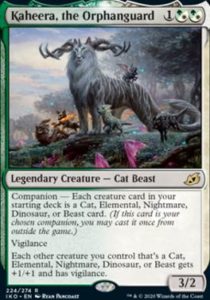
Let’s start with that last group. For years the ideal control deck was basically a no-wincons, chock full of countermagic and removal draw-go pile, but times have changed, and you need some way to close out the game. The reason for this is twofold – gameplay and logistics. What I mean by gameplay is that with how much stronger threats, and proactive cards in general, has become in 2023 in comparison to 2003, you can’t always have a complete control of the game – between cast triggers, utility lands and uncounterable spells, you can’t just be content sitting behind a counterspell indefinitely. The second part is logistics, and its importance wildly varies depending on the medium you’re using to play the game. On Magic Online, if you’re not double queuing and your internet connection is stable, you should have no problems winning in time in the vast majority of cases. In paper, on the other hand, it can get a bit tricky, especially if you’re not the fastest player. My advice would be to practise so you’re comfortable with a higher pace of play, but having an actual deckbuilding concession to winning in a reasonable time frame helps tremendously as well. Before MH2, you’d just lean on planeswalkers such as Teferi and Jace, but with Unholy Heat in the mix it’s so much harder to do so. Ideally, you would have a wincon that’s somewhat incidental but decisive, such as Narset and Days, which is made significantly easier to put together with the sheer amount of cards from The One Ring. Once again, you can see how I naturally gravitate towards combo control – it’s just the most elegant and compact solution to close out the game in a short period of time. Of course, having some more wincons, especially “free” ones like Solitude and Kaheera is extremely helpful as well, especially if your combo gets boarded out a bunch and/or doesn’t actually kill your opponent, just locks them out of the game.
Card advantage, as I already mentioned, is what ensures you’ll take over the game. The One Ring is basically the perfect tool for that, as it’ll almost assuredly run away with the game given enough time – and in its case, “enough time” usually means two or three turns. With such a potent way of accruing card advantage, I like the rest of my deck to be lean and not too heavy on extra card advantage – I do have some incidental ways of getting that, between Narset and Lorien Revealed, but because of how durable and effective the Ring is, you don’t need much to actively look for more firepower in that department.
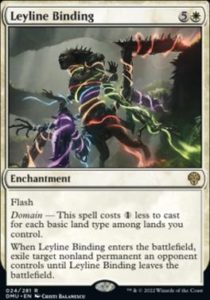
This leaves us with the most crucial part of any reactive deck: interaction. While you can always find some ways to close out the game more or less efficiently once you take over control, and burying opponents under a heap of cards isn’t a necessity, as there are other ways to pull ahead later in the game, having proper means of responding to hostile plays is absolutely key when trying to play an interactive game.
The two most important factors in my opinion when evaluating your interaction suite is versatility and efficiency. The former used to be somewhat hard to come by in Modern, but with the addition of cards such as Counterspell, Prismatic Ending and Leyline Binding, long gone are the days of Path to Exiles and Mana Leaks matching up poorly at what your opponent is doing. I think Counterspell, and countermagic in general, deserves a little extra attention – nowadays, a bulk of attrition-based decks in Magic are solidly in the battlecruiser camp, chock-full of however many two, or even more, for ones can be squeezed into them. This type of cards are historically excellent against any sort of on-board interaction, as they provide some, often significant, amount of value even in the face of removal. Countermagic is basically the only class of cards that will trade with opposing haymakers on a one for one basis, barring some rare exceptions like cast triggers, which prevents games from spiralling out of control before the control deck’s endgame can take over. As an added bonus, it even trades up on mana quite often, especially when facing those hard to answer otherwise haymakers that tend to cost a fair amount. As far as efficiency goes, we obviously have the aforementioned trifecta – neither one nor two mana is too prohibitive of a cost to pay for interacting in Modern, but you know what’s much better than that? Paying zero mana for your interaction. I think that all three of Force of Negation, Subtlety and especially Solitude are a big part of why UW is well-positioned right now. If you’re willing to branch into other colours, it’s pretty likely you’ll include some other free spells in your deck, such as Fury, Force of Vigor or even Commandeer in concert with Beans, just to name a few. With the sheer amount of extra cards contemporary value engines can generate, mana is a much more limiting factor than card quantity, so having a chance to offload your hand and trading with your opponent’s board.
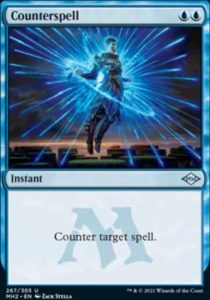
Another aspect of interaction that’s incredibly important, but even more contextual and thus often harder to get right than the aforementioned two is picking the appropriate suite of answers for the expected field. This, in my opinion, is the part that people tend to struggle with the most. Too often I see decks with upwards of fifteen removal spells but less than four of them answer Ragavan, arguably the most impactful creature in the format, in a satisfactory manner. Similarly, playing slow attrition decks without any sort of countermagic is extremely exploitable in my opinion, and a good part of why various wonky decks pop out any time Modern community gets a bit too high on those overindulgent Four Colour piles of Shriekmaws and Divinations. Lastly, putting even more premium on versatility, even if it comes at the cost of some efficiency, if the format is saturated with troubling noncreature permanents. A good example would be the rise in Prismatic Ending’s and Leyline Binding’s stock compared to much more efficient Unholy Heats and Lightning Bolts once The One Ring and Agatha’s Soul Cauldron became format’s mainstays.
One last point I’d like to make on the topic of interaction is how sometimes a certain piece of it works so well with the overall gameplan that it basically forces you to play a particular colour. It’s fairly rare, but I think we’re witnessing this right now with Solitude and The One Ring. It’s no incident that the most successful midrange and control decks sporting The One Ring are white-based. Of course, you can argue that Solitude is just an overpowered card (it is), and that other white spells are so strong that you want to play them anyways (they are), but this particular pairing has proven time and time again to be crucial, and is also proven by the fact that non-white control decks largely disappeared, and those that persevered mostly abandoned Ring as a source of card advantage and moved more into the Wafo-Tapa style of draw-go control.
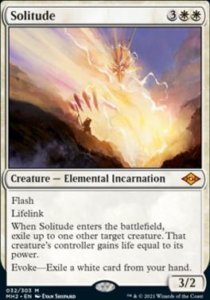
Not losing to your deck
Magic players as a collective are pretty bad at gauging the probability of winning any given matchup. This is by far the most prevalent when talking about two decks facing off where the favourite is clear, as people quite often like to throw some insane percentages around, like “this matchup is at least eighty percent”. There are some exceptions of course, but largely there are no matchups that are over seventy or so percent between any top tier, or even ten most popular decks in Modern. That’s mostly because of how much better decks got and how much lower their fail rate is compared to the past eras of Modern. For example, even in its worst matchups, you can count on Scam having a turn one Evoke elemental in a good amount of games, especially if they aggressively mulligan seven card hands without such openings, or Murktide going Ragavan into Counterspell and snowballing the game out of control (I wanted to give you more precise numbers on that, but couldn’t find any working multivariate hypergeometric calculator online. If you know such software, please reach out to me on Twitter, I’ll be very grateful!). What I’m trying to say, maybe in a bit too of a roundabout way, is that basically every deck in Modern these days has some sort of powerful start that will likely overpower even its bad matchups. Conversely, any archetype will have some amount of poor openings, heavy mulligans and other misfortunes that will make it difficult to defeat even the most favourable pairing. This fail rate is what I want to cover right now.
Two most common ways of losing to your own deck are heavy mulligans and quantitative mana problems. The first one can be addressed by having some extraordinarily powerful lines of play that will get you out of this severe card disadvantage. Cards like The One Ring or Up the Beanstalk can generate so much value over time that if you manage to stick one of them, it won’t matter all that much with how many cards you started. Any ramp deck and most combo decks operate under similar assumptions – your endgame will either provide enough card advantage, virtual or not, or just straight-up kill your opponent, so any prior resource imbalance won’t make any significant difference. A newer, and to some maybe a bit less apparent example of this is probably the most feared opening in Modern – double Grief (or to some extent Fury) on turn one. Even if Scam is starting from five cards, there’s a good chance that double discard will completely decimate the opposing line of defence, and the resurrected Elemental will finish the game before the opponent draws their way out of this troublesome situation. Going back to control though, I already mentioned that The One Ring is a great way to effectively undo your mulligans, but it’s nice to have more than one way to do so, especially if it also does other things aside from amassing cards in hand. Here’s where any type of combo finish shines again – with that additional route to get us out of the initial card disparity you should be relatively likely to get back into the game after going down to five cards (and of course six, but I barely consider going down to six cards a mulligan these days with the current set of rules and the raw power level of cards).
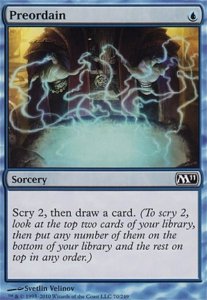
As far as quantitative mana problems go, you can either draw too many or too few lands. Flooding out is much less likely these days with how much value is incidentally stapled to every card, so the most important thing to ensure in this department is not getting mana screwed. The easiest and most impactful thing you can do is simply playing more lands. I remember some pro player saying a few years ago that the first thing they do when picking up a new deck is cutting a card or two from a stock list in favour of some extra lands, and most of the time it improves their winrate. I think it’s a pretty good practice, especially if you can increase your effective land count in a different way than just cutting spells for them. Historically, cantrips were the premier way of doing so, and I heavily recommend at the very least trying to incorporate some of them into your deck. Preordain has been banned for over a decade, and while I don’t think it’s too strong for Modern, it’s still an extremely potent card in my eyes and one that bolsters any deck running it in a bunch of subtle ways. Another new and absolutely amazing tool in this department is the Lord of the Rings land cycling cycle, especially Lórien Revealed – unlike cantrips, they’re guaranteed to get you a land, and you can effectively count them as such while building your deck. Of course they come with some drawbacks, as they effectively cost one mana to get, which makes them into taplands if you topdeck one, and they can be taken with discard spells, which makes them somewhat of a liability in certain matchups, especially in otherwise landlight draws. On the other hand, they have other functionality, and Lorien Revealed is the one with the most potent spell side – drawing three cards for five mana is not an amazing rate by any means, but it’s often exactly what you need when going off the top of your deck and low on resources. It also works extremely well with pitch cards, by both inflating your blue count for them and being a way to refill your grip after using a bunch of them.
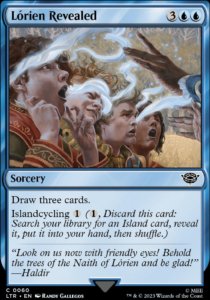
Speaking of pitch cards, I know I’ve sung their praises more than once already, but I think it’s really important to realise how busted they are. After mana problems and mulligans, the next two most likely ways of losing to your deck that I can think of right now are having clunky draws, ie. dying with cards still in your hand, and getting run over on the draw. Pitch cards are obviously insane in the first case, since trading cards for tempo is all you want to do in these spots, but I think that the second scenario is more interesting and needs to be covered more extensively, as people often dismiss it. I remember watching Reid Duke playing some wonderful but woefully bad RUG control deck in Modern ages ago, and he ran three maindeck Spell Snares and four two mana counterspells in times when loading on up to six or seven Remands and/or Mana Leaks was the industry standard. When asked about it, he said “well, you’re gonna be on the draw half of the time won’t you?”, and it really stuck with me. Ever since then, I’ve been trying to pack as many Spell Snares and Pierces in most of my lists, and while this particular deck runs none, it has other ways of swinging the tempo on the draw (pitch cards, duh), and even with them I’m not convinced it shouldn’t run some number of Pierces somewhere in the seventy five (I’m going to figure it out once I’m back from my holiday). Specifics aside, what I wanted to convey is that it’s important to envision how your games on the draw will play out and have a sound game plan for when you’re playing second.
Who’s the beatdown (but in deckbuilding)
If you’re at all familiar with Magic theory literature, there’s a very good chance you’ve at least heard about the legendary article by Mike Flores entitled “Who’s The Beatdown?”. It might not bear the same sense of wonder as it used to, given how much Magic theory progressed in the almost twenty five years since it was first published, but it’s still one of the most fundamental pieces written about the game and a subject that every Magic player needs to be familiar with, even if only instinctively. And while the article in question pertains to gameplay, the same question can be, at least in my opinion, asked in terms of deckbuilding.
The very premise of “Who’s The Beatdown?” is wonderfully simple and elegant: at any given point, in any given matchup, there’s an aggressor and a defender. The roles can shift mid-game, often even multiple times during a single turn cycle when it comes to certain decks (historically Faeries have been balancing this fine line with a grace of a trapeze acrobat, and Murktide (or tempo decks in general) are more recent examples of an archetype more fluid in this regard), but in the vast majority of cases, deck X will be the aggressor in matchup Y every single time at the start of the game. You need to be able to assess which role you need to take on, and unless you’re positive that you’re either beatdown or control in every single matchup, you need to have reasonable plans for both scenarios.
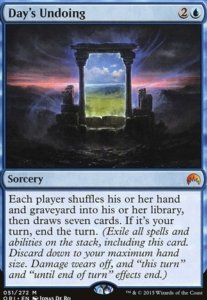
Being the defensive side while playing control is relatively easy, or at least easier to grasp for most people than being the aggressor. After all, it’s right there in the name – you’re playing control, so it only makes sense that you’ll be the controlling party. Your deck will usually be slanted in a way that naturally benefits from prolonging the game, so you shouldn’t worry too much about that. A much more interesting scenario is when you’re finding yourself as an aggressor while playing a traditionally reactive deck. You need to have a plan for those situations, and you want it to be better than a pile of Bolts and Snapcaster Mage beatdowns – don’t get me wrong, it’s a wonderful way to end the game and one of my all-time favourites, but it’s good enough as a cleanup after taking control, not when you need to decisively take over. For those scenarios, unsurprisingly to anyone reading, I’d recommend having some sort of combo, or at least a soft-lock type of setup. Having an actually coherent plan for when you need to be the proactive side will make it much easier for you to find wins in those matchups. You might ask yourself: what are such matchups for control these days? Unlike some people would tell you, Tron isn’t such a matchup (and it’s a topic I’ll try to address more later on, as there seems to be a collective obsession about the Tron matchup between the majority of control players on the planet). I’d say that combo decks that run permission will often be in this category, such as Living End, Ad Nauseam or now extinct Storm. Whenever you’re wondering about which role to take, you should ask yourself the following questions: who’s gonna win if we both draw our decks? What about if both players sculpt the perfect seven card hand on turn ten? If the answer to these questions isn’t you, it’s likely that it’s in your best interest to either finish the game or at least lock it up (eg. Teferi against Living End, Narset + Day’s against any combo) before the aforementioned endgames take place.
Combo control as the holy grail of blue
Now we’re getting to the gist of this article, and the biggest reason I think it’s important to have different options in your wheelhouse: I think in this day and age, a true control deck will very rarely be good if it doesn’t have some sort of combo or otherwise “unfair” (I hate this word so much, but I couldn’t figure out a better alternative) element to it. What I mean by “unfair” isn’t necessarily what people longing for solitaire Magic or at least the Faithless Looting unban have in mind, but it somewhat covers a part of it. In the post-Push Modern format (an arbitrary guideline I know, but the one that’s very distinct and as good as any similar milestone in my opinion), every control deck that enjoyed broad success shared one of the two following traits. First one was either a ridiculously overpowered centrepiece (Oko, Uro), something that allowed it to cross lines that were previously impossible to cross (Arcum’s Astrolabe), or things that were a bit of both (Mystic Sanctuary, Field of the Dead). Every single of these cards had a profound effect on how the format looked at large, and were deservedly so banned (whether some of them, notably Arcum’s Astrolabe, should remain banned is a whole different conversation for a different day). The second, much less distinctive, but nevertheless equally important, group are decks revolving around Teferi, Hero of Dominaria (and to some extent Jace, but Teferi is a much more clear example of what I’m trying to illustrate). Ever since the powerful planeswalker was released, many people tried to harness his power and a bunch of them succeeded, creating what effectively was a combo control deck in my eyes. Basically in any period of time where Teferi decks shined, he virtually had hexproof, and his natural tankiness made him difficult to remove via creature combat. Think back to the dark times of Heliod vs Prowess duel decks, just prior to the MH2 release – Esper Control was enjoying a good amount of success, in the hands of both Wafo and yours truly, and I always attributed it to the fact that once you’ve landed a Teferi, untapping with it was quite likely, and if you’ve managed that, so did winning the game. Why was that the case? We didn’t have Unholy Heat back then, and the sheer speed and efficiency of both Heliod and Prowess made cards that could answer Teferi, like Maelstrom Pulse or Assassin’s Trophy, much too slow. Similarly, anytime Death’s Shadow rose as the go-to interactive deck, Teferi was there as the foil to the efficient but ill-equipped to answer him Grixis machine. Sure, Stubborn Denial is pretty effective at combating sorcery-speed five drops, but between an overabundance of removal on the control side, Field of Ruin to disrupt the mana and the need for Shadow to tap out at some point, it wasn’t too hard to engineer the situation where landing Teferi had high chances of success.
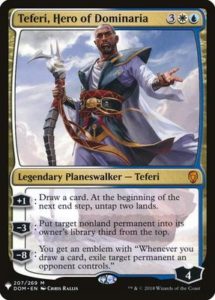
I hope this excruciatingly long introduction made some sense to you, but in case it didn’t or you decided to skip it, which I can’t blame you for too much, the TL;DR of it is that unless you have a broken card to build your control deck around, you need some combo, or at least combo-adjacent element to succeed. It’s important to acknowledge that when I talk about control, I mean traditional control decks with countermagic, board wipes and all that jazz, not some piles of Shriekmaws and Divinations like most Four Colour decks we’ve seen in the last few years. I don’t have anything against them (well, aside from the fact that they’re often misbuilt in my opinion), but they aren’t exactly my area of expertise, nor the subject of this article. Going back to combo control though: when the combo element of those decks is good, they’re all upside over traditional hard control, and that’s exactly where you should pick up your Supreme Verdicts and Solitudes in my opinion. How to determine when that’s the case? Allow me to elaborate.
One of the biggest advantages of combo control in my eyes is that you have a clear way of winning against other attrition decks without engaging in the endless (and aforementioned) arms race, thus sacrificing efficiency in the process. That marks the first of my requirements for the combo I plan on including in my deck: it has to be at least moderately efficient, both mana and slots-wise. I’m not looking for a two card combo that forces me to put eight five drops in my deck, or even something uncastable like Emrakul, the Aeons Torn and Through the Breach. With the fourth turn being absolutely crucial in many games with blue-white, seeing that you want to deploy either The One Ring or Supreme Verdict as soon as possible fairly often, ideally at least one of the combo elements should be possible to play before the fourth turn. Of course those guidelines changes depend on your deck and cards available in the format – I could easily imagine an environment and a deck in which turn three is the most important one, so that the difference between three or four mana for your combo piece isn’t as significant since you won’t be able to deploy it prior to that pivotal turn anyways. Sure, you can theoretically find a combo based on one or two mana permanents, but based on how the Magic design works, coupled with my next requirement, I’d be very surprised if we’ll ever see such cards being printed.
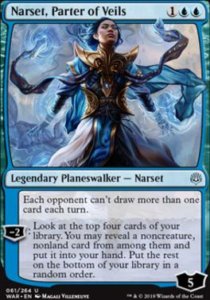
The second pillar that’s vital to the success of combo control is, unsurprisingly, card quality of your pieces. If your two card kill requires a pair of otherwise useless pieces of cardboard to work together, it’s not a good combo for a combo control deck. By the nature of the archetype, you’ll have to play a good amount of straight-up control games with it, and there will be matchups where you’ll take at least one part of your combo out in sideboarding. Because of that, I like at least one of my combo pieces to be a good standalone card. In this particular deck, Narset fills that role, as her passive is very effective in a variety of matchups, and even when it’s not great, the double Impulse makes finding your important cards fairly easier. Ideally, the other half would also be a decent card on rate, but when it’s not the case, like here with Day’s Undoing, it’s good to have other uses for them. In this case it means getting pitched to Force of Negation and Subtlety – fairly often you need any blue cardboard, and Day’s make the cut here.
You might ask yourself “why all the trouble? Can’t I just jam my favourite walkers, card advantage and interaction and call it a day?” Well, I don’t think that cuts it anymore. The combo aspect helps you shore many weaknesses that I outlined throughout this article – clunkiness caused by the attrition war, closing games in time, both from the gameplay and round clock perspectives, and finally allowing potential nut draws which is invaluable in the open field of most large tournaments. Combo makes your deck leaner, more threatening and harder to exploit – it’s just a complete package (if built properly of course), and I don’t intend on registering a non-combo control deck in Modern anytime soon unless the format changes considerably.
Building good sideboards
The last, but definitely not least, topic I wanted to touch upon regarding deckbuilding is constructing proper sideboards. There are many excellent deckbuilders that built horrible sideboards in my opinion, and while there are different schools of approaching this enormous task, I believe, ever so insolent, that what I’m about to present is the right way of doing so.
Something that has always been hard for me to understand is how people fairly often devote considerable resources to build a great maindeck but constructing the right sideboard is barely an afterthought. This made little sense to me because by definition you’ll play at least as many sideboarded games in the tournament as preboarded, and on top of that it’s literally impossible to win a match of Magic without picking up at least a single win postboard. Due to both of these factors, the sideboarded games have significantly higher impact on your performance than preboarded ones, yet many players, especially less experienced ones, focus on cramming as many games as possible against their friends, often exclusively with their starting sixties, and classify it as “good testing”. Testing is a very broad topic in itself, and I don’t want to derail myself and make this article even longer than it already is, so I’m gonna give you a single, even if extreme, example of how important using your sideboard properly is. Imagine that you’re playing a matchup that’s literally zero percent preboard. I mean if you do nothing but play this matchup preboard for the rest of your life, you will never win a single game of Magic. Yet if you can make it into seventy percent postboard, it becomes a coin flip overall. Slightly weighted one, as your opponent will be a fifty one percent favourite to take down the match, but it’s still a major improvement from literal zero percent. Of course there are no zero percent matchups in Magic, and even if there were it would take an extremely bizarre set of circumstances to take it from zero to seventy with just fifteen extra cards, but I still like using this example as it illustrates the importance of the postboard games very well. More reasonable numbers to apply the same philosophy would be those: if your preboard matchup is forty percent, you need at least fifty five postboard to be even. Or twenty nine preboard and sixty postboard, you get the gist. Sideboard games matter a ton and you should work as hard, if not harder, on them, and your sideboard as a result than on your maindeck. Well that was a lot of blabbering to convey a relatively straightforward concept, wasn’t it? Let’s get to some actual advice on how to build better sideboards.
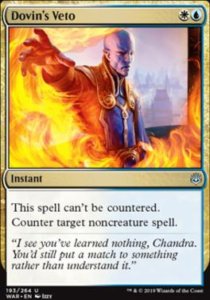
Let’s get one thing straight right away: what matters in deck construction in general is maximising your win percentage across the board, not winning every matchup. In fact, you can’t win every matchup unless your deck is beyond broken and usually you’ll lower your overall winrate if you try and salvage every single pairing. The best example would be Emrakul, the Aeons Torn against Mill – unless you’re positive that there will be a significant number of Mill players in the room, you’re better off devoting this slot towards something more broad. This illustrates my general approach to building sideboards: I like playing broad cards with potentially lower individual impact over narrow hosers, unless you’re targeting a supremely popular archetype with them. There’s nothing wrong with quad Rest in Peace in the Hogaak meta, but it doesn’t mean you should run any if there’s one percent chance of running into Dredge or Oops. But it’s not as simple as playing a softer but broader hate such as Relic of Progenitus – if it was then people would figure it out en masse ages go. It’s all about trying to build the setup that eliminates the need for targeted hate and allows you to have one, universal plan for every matchup that people traditionally love to salvage with silver bullets. Sounds too good to be true? Maybe it is, and maybe I’m extremely delusional and my recent streak was nothing more than blind luck, but I think there’s a sound logic behind all this that I’m trying to unveil with this text.
The most common question I get asked when it comes to my decklist is what are the additional copies of Narset and Day’s in the board for. Well, that’s not true – the most common question is about my Tron matchups, since control players are collectively obsessed about it for some reason, but the Narset/Day’s question follows the Tron one closely. The answer is quite simple – instead of trying to pack dedicated hate against every deck in the format into an already stretched sideboard, I’ve decided to load up on combo pieces and transform into an even more focused combo deck, as sort of a skeleton key approach to every linear opponent. This way I have a coherent plan that’s already supported by my maindeck and requires minimal amount of sideboard space, which brings me to my next point: sideboard efficiency.
Because your sideboard is limited to fifteen (or in this case fourteen) cards, every single slot is extremely valuable. There are few things I hate more in tournament Magic than showing up for an event with a card in my board and ending up bringing it in zero times over the course of fifteen rounds. Of course, sometimes it’ll be just some unfortunate variance – if you have a card that covers thirty percent of the metagame and you end up facing that part of it zero times, that’s just an insanely bad luck (it’ll happen less than half percent of time to be more accurate), and there’s nothing to be mad about there. But if you have a card that you will only bring against five percent of the field (which is conveniently about the current metagame share of Tron), there’s a little over forty five percent that you will face it zero times over a two day event. If you’re going to an eight round PTQ or Challenge-style tournament instead, this number goes up to two thirds. In this case, at least in my opinion, it’s on you. Unless this card is so extremely impactful that it ends the game on the spot every time you draw with it no counterplay in the matchup that’s otherwise abysmal, I wouldn’t run anything that covers less than high teens/low twenties of the field. Of course we’re still talking about those five percenters – for anything less popular, please refer to the Emrakul/Mill comment I made at the beginning of this section. All these ramblings about percentages are here to help you realise how precious every slot in your board is and how much you gain by having compact and versatile sideboard plans.
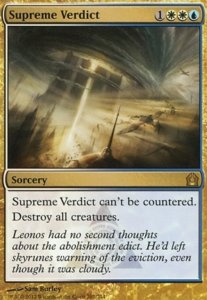
Another underutilised concept is running more copies of your good maindeck cards in the board. If you don’t have space for the fourth Lightning Bolt in your starting sixty, but you think it’s worth having it against numerous archetypes, what prevents you from including it in your sideboard? Remember that your seventy five should be one fluid and coherent entity, not two completely separated groups of cards kept in the same deck box.
Last thing I want to focus on is another extremely important tool – sideboard maps. Mapping prevents you from having wasteful sideboards, keeping track of various things like number of coloured cards for your pitch spells, and ensures that you’re not caught unhappy with some of your postboard configurations mid-tournament. The most convenient way of mapping your sideboarding is using one of the greatest inventions humanity has to offer, an Excel spreadsheet, put your maindeck and sideboard in one column, matchups you expect in subsequent columns and just balance cards you take out and ones you bring in. You can also use one of many softwares designed by passionate members of the community. My personal favourite is FlexSlot by George Jabbour – you can find his Twitter with all the links here. George has been involved in a lot of cool stuff that makes Magic a better place for everyone, so shout out to him – I appreciate all your hard work.
The last message for you
If you made it here, this means that you endured almost twenty pages of me rambling about things vaguely connected to building good decks in Modern. At this point I’d like to thank you for taking the effort of reading all this, as this is precisely why I do what I do – I want to share my takes, even those that are widely misguided, on the game that I love with other people who’re passionate about it. I hope you got something out of this article, and I’ll see you next time.
